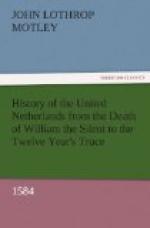Invisible as the Grand Lama of Thibet, clothed with power as extensive and absolute as had ever been wielded by the most imperial Caesar, Philip the Prudent, as he grew older and feebler in mind and body seemed to become more gluttonous of work, more ambitious to extend his sceptre over lands which he had never seen or dreamed of seeing, more fixed in his determination to annihilate that monster Protestantism, which it had been the business of his life to combat, more eager to put to death every human creature, whether anointed monarch or humble artizan, that defended heresy or opposed his progress to universal empire.
If this enormous power, this fabulous labour, had, been wielded or performed with a beneficent intention; if the man who seriously regarded himself as the owner of a third of the globe, with the inhabitants thereof, had attempted to deal with these extensive estates inherited from his ancestors with the honest intention of a thrifty landlord, an intelligent slave-owner, it would have yet been possible for a little longer to smile at the delusion, and endure the practice.
But there was another old man, who lived in another palace in another remote land, who, in his capacity of representative of Saint Peter, claimed to dispose of all the kingdoms of the earth—and had been willing to bestow them upon the man who would go down and worship him. Philip stood enfeoffed, by divine decree, of all America, the East Indies, the whole Spanish Peninsula, the better portion of Italy, the seventeen Netherlands, and many other possessions far and near; and he contemplated annexing to this extensive property the kingdoms of France, of England, and Ireland. The Holy League, maintained by the sword of Guise, the pope’s ban, Spanish ducats, Italian condottieri, and German mercenaries, was to exterminate heresy and establish the Spanish dominion in France. The same machinery, aided by the pistol or poniard of the assassin, was to substitute for English protestantism and England’s queen the Roman Catholic religion and a foreign sovereign. “The holy league,” said Duplessis-Mornay, one of the noblest characters of the age, “has destined us all to the name sacrifice. The ambition of the Spaniard, which has overleaped so many lands and seas, thinks nothing inaccessible.”
The Netherland revolt had therefore assumed world-wide proportions. Had it been merely the rebellion of provinces against a sovereign, the importance of the struggle would have been more local and temporary. But the period was one in which the geographical land-marks of countries were almost removed. The dividing-line ran through every state, city, and almost every family. There was a country which believed in the absolute power of the church to dictate the relations between man and his Maker, and to utterly exterminate all who disputed that position. There was another country which protested against that doctrine, and claimed, theoretically or practically, a liberty




